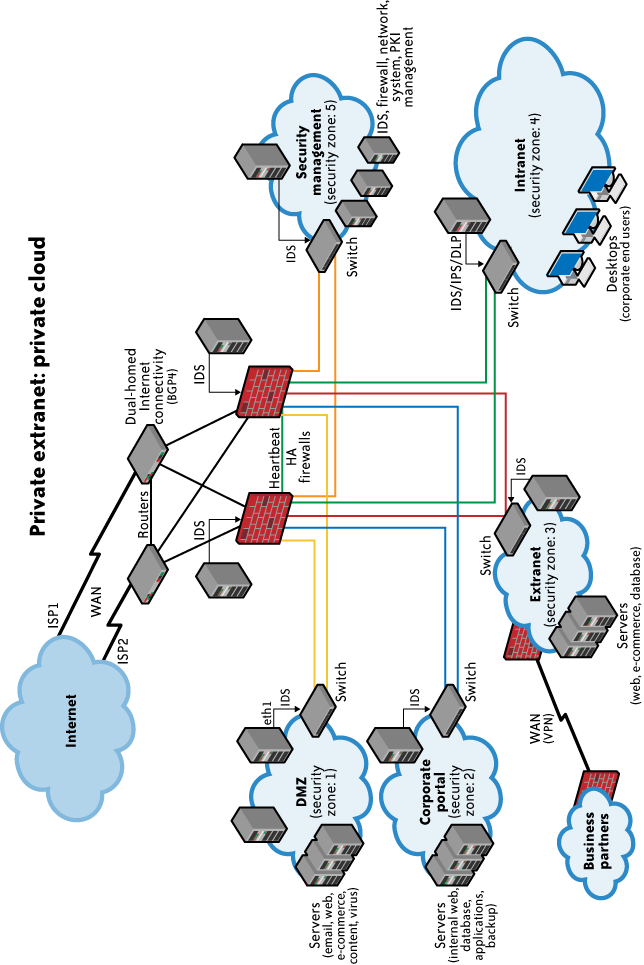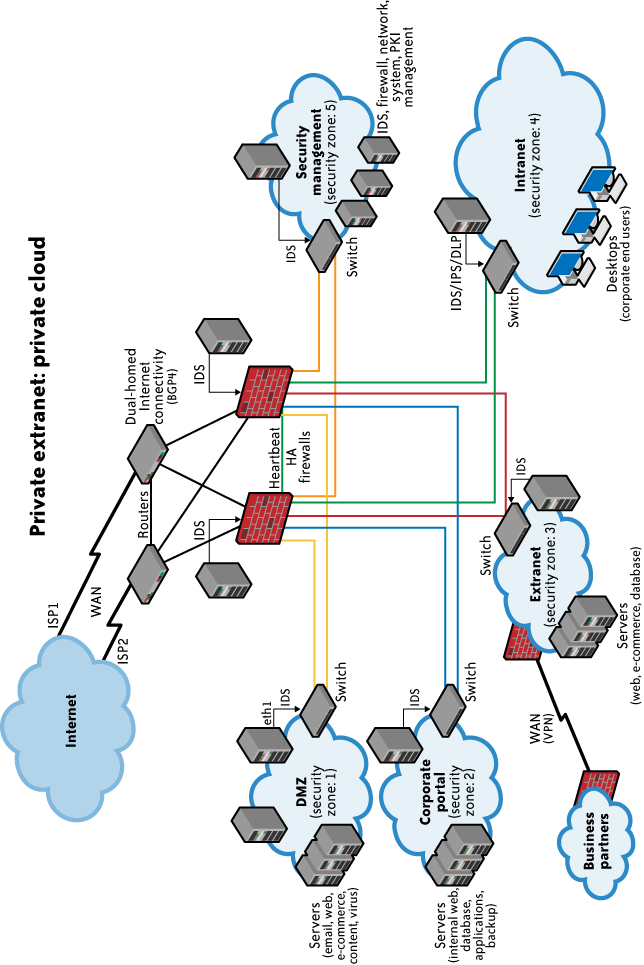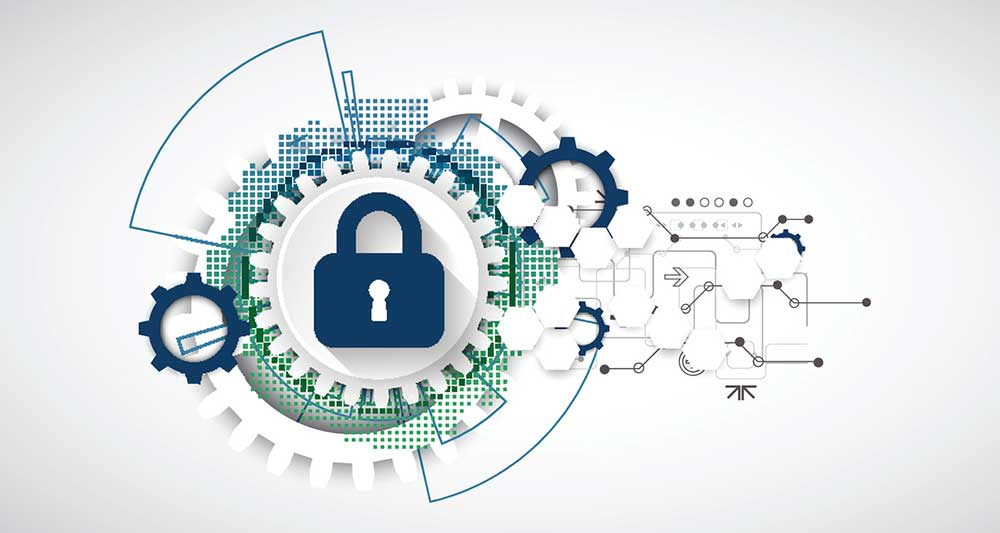When looking at the network level of infrastructure security, it is important to distinguish between public clouds and private clouds. With private clouds, there are no new attacks, vulnerabilities, or changes in risk specific to this topology that information security personnel need to consider. Although your organization’s IT architecture may change with the implementation of a private cloud, your current network topology will probably not change significantly. If you have a private extranet in place (e.g., for premium customers or strategic partners), for practical purposes you probably have the network topology for a private cloud in place already. The security considerations you have today apply to a private cloud infrastructure, too. And the security tools you have in place (or should have in place) are also necessary for a private cloud and operate in the same way. Figure 1 shows the topological similarities between a secure extranet and a private cloud.
However, if you choose to use public cloud services, changing security requirements will require changes to your network topology. You must address how your existing network topology interacts with your cloud provider’s network topology. There are four significant risk factors in this use case:
-
Ensuring the confidentiality and integrity of your organization’s data-in-transit to and from your public cloud provider
-
Ensuring proper access control (authentication, authorization, and auditing) to whatever resources you are using at your public cloud provider
-
Ensuring the availability of the Internet-facing resources in a public cloud that are being used by your organization, or have been assigned to your organization by your public cloud providers
-
Replacing the established model of network zones and tiers with domains
We will discuss each of these risk factors in the sections that follow.
1. Ensuring Data Confidentiality and Integrity
Some resources and data previously confined to a private network are now exposed to the Internet, and to a shared public network belonging to a third-party cloud provider.
Figure 1. Generic network topology for private cloud computing

An example of problems associated with this first risk factor is an Amazon Web Services (AWS) security vulnerability reported in December 2008.[4] In a blog post, the author detailed a flaw in the digital signature algorithm used when “… making Query (aka REST) requests to Amazon SimpleDB, to Amazon Elastic Compute Cloud (EC2), or to Amazon Simple Queue Service (SQS) over HTTP.” Although use of HTTPS (instead of HTTP) would have mitigated the integrity risk, users not using HTTPS (but using HTTP) did face an increased risk that their data could have been altered in transit without their knowledge.
[4] This issue was reported on the blog of Colin Percival, “Daemonic Dispatches,” on December 18, 2008. See “AWS signature version 1 is insecure”. There was no public acknowledgment of this issue on the AWS website, nor any public response to Percival’s blog posting.
2. Ensuring Proper Access Control
Since some subset of these resources (or maybe even all of them) is now exposed to the Internet, an organization using a public cloud faces a significant increase in risk to its data. The ability to audit the operations of your cloud provider’s network (let alone to conduct any real-time monitoring, such as on your own network), even after the fact, is probably non-existent. You will have decreased access to relevant network-level logs and data, and a limited ability to thoroughly conduct investigations and gather forensic data.
An example of the problems associated with this second risk factor is the issue of reused (reassigned) IP addresses. Generally speaking, cloud providers do not sufficiently “age” IP addresses when they are no longer needed for one customer. Addresses are usually reassigned and reused by other customers as they become available. From a cloud provider’s perspective this makes sense. IP addresses are a finite quantity and a billable asset. However, from a customer’s security perspective, the persistence of IP addresses that are no longer in use can present a problem. A customer can’t assume that network access to its resources is terminated upon release of its IP address. There is necessarily a lag time between the change of an IP address in DNS and the clearing of that address in DNS caches. There is a similar lag time between when physical (i.e., MAC) addresses are changed in ARP tables and when old ARP addresses are cleared from cache; an old address persists in ARP caches until they are cleared. This means that even though addresses might have been changed, the (now) old addresses are still available in cache, and therefore they still allow users to reach these supposedly non-existent resources. Recently, there were many reports of problems with “non-aged” IP addresses at one of the largest cloud providers; this was likely an impetus for an AWS announcement of the Amazon Elastic IP capabilities in March 2008.[5] (With Elastic IP addresses, customers are given a block of five routable IP addresses over which they control assignment.) Additionally, according to Simson Garfinkel:
[5] See “Announcing Elastic IP Addresses and Availability Zones for Amazon EC2”. Though announced in March 2009, the Elastic IP service became available October 22, 2008.
A separate ongoing problem with the load balancers causes them to terminate any TCP/IP connection that contains more than 231 bytes. This means that objects larger than 2GB must be stored to S3 in several individual transactions, with each of those transactions referring to different byte ranges of the same object.[6]
[6] See Section 3.3, “An Evaluation of Amazon’s Grid Computing Services: EC2, S3 and SQS,” by Simson L. Garfinkel; TR-08-07, Computer Science Group, Harvard University, Cambridge, Massachusetts.
However, the issue of “non-aged” IP addresses and unauthorized network access to resources does not apply only to routable IP addresses (i.e., resources intended to be reachable directly from the Internet). The issue also applies to cloud providers’ internal networks for customer use and the assignment of non-routable IP addresses.[7] Although your resources may not be directly reachable from the Internet, for management purposes your resources must be accessible within the cloud provider’s network via private addressing. (Every public/Internet-facing resource also has a private address.) Other customers of your cloud provider may not be well intentioned and might be able to reach your resources internally via the cloud provider’s networks.[8] As reported in The Washington Post, AWS has had problems with abuses of its resources affecting the public and other customers.[9]
[7] See RFC 1918, “Address Allocation for Private Internets,” for further information.
[8] For example, see “Instance Addressing and Network Security” in the Amazon Elastic Compute Cloud Developer Guide (API Version 2008-12-01).
[9] “Amazon: Hey Spammers, Get Off My Cloud!” reported in The Washington Post, July 1, 2008.
Some products emerging onto the market[10] will help alleviate the problem of IP address reuse, but unless cloud providers offer these products as managed services, customers are paying for yet another third-party product to solve a problem that their cloud provider’s practices created for them.
[10] An example is CohesiveFT’s VPN-Cubed, but this product is not available as a cloud provider service from most cloud providers—which would mean yet another third-party solution to integrate into your cloud environment. However, cloud provider AWS does offer this product as a service.
3. Ensuring the Availability of Internet-Facing Resources
Reliance on network security has increased because an increased amount of data or an increased number of organizational personnel now depend on externally hosted devices to ensure the availability of cloud-provided resources. Consequently, the three risk factors enumerated in the preceding section must be acceptable to your organization.
BGP[11] prefix hijacking (i.e., the falsification of Network Layer Reachability Information) provides a good example of this third risk factor. Prefix hijacking involves announcing an autonomous system[12] address space that belongs to someone else without her permission. Such announcements often occur because of a configuration mistake, but that misconfiguration may still affect the availability of your cloud-based resources. According to a study presented to the North American Network Operators Group (NANOG) in February 2006, several hundred such misconfigurations occur per month.[13] Probably the best known example of such a misconfiguration mistake occurred in February 2008 when Pakistan Telecom made an error by announcing a dummy route for YouTube to its own telecommunications partner, PCCW, based in Hong Kong. The intent was to block YouTube within Pakistan because of some supposedly blasphemous videos hosted on the site. The result was that YouTube was globally unavailable for two hours.[14]
[11] Border Gateway Protocol is an interdomain routing protocol used in the core of the Internet. You can find more information about BGP in RFC 4271, “A Border Gateway Protocol 4 (BGP-4).”
[12] According to RFC 1930, “Guidelines for Creation, Selection, and Registration of an Autonomous System (AS),” an autonomous system is a connected group of one or more IP prefixes run by one or more network operators that has a single and clearly defined routing policy.
[13] See “Short-Lived Prefix Hijacking on the Internet” by Peter Boothe, James Hiebert, and Randy Bush, presented at NANOG 36 in February 2006.
[14] For example, see “Pakistan Cuts Access to YouTube Worldwide” in The New York Times, February 26, 2008.
In addition to misconfigurations, there are deliberate attacks as well. Although prefix hijacking due to deliberate attacks is far less common than misconfigurations, it still occurs and can block access to data. According to the same study presented to NANOG, attacks occur fewer than 100 times per month. Although prefix hijackings are not new, that attack figure will certainly rise, and probably significantly, along with a rise in cloud computing. As the use of cloud computing increases, the availability of cloud-based resources increases in value to customers. That increased value to customers translates to an increased risk of malicious activity to threaten that availability.
DNS[15] attacks are another example of problems associated with this third risk factor. In fact, there are several forms of DNS attacks to worry about with regard to cloud computing. Although DNS attacks are not new and are not directly related to the use of cloud computing, the issue with DNS and cloud computing is an increase in an organization’s risk at the network level because of increased external DNS querying (reducing the effectiveness of “split horizon” DNS configurations[16]) along with some increased number of organizational personnel being more dependent on network security to ensure the availability of cloud-provided resources being used.
[15] DNS stands for Domain Name System. See RFCs 1034, “Domain Names—Concepts and Facilities,” and 1035, “Domain Names—Implementation and Specification.”
[16] That is not to say that internal DNS systems are entirely free of attacks—just that they are safer than external DNS systems and queries using them. For example, see the paper “Corrupted DNS Resolution Paths: The Rise of a Malicious Resolution Authority,” written by members of the faculty of the Georgia Institute of Technology.
Although the “Kaminsky Bug”[17] (CVE-2008-1447, “DNS Insufficient Socket Entropy Vulnerability”) garnered most of the network security attention in 2008, other DNS problems impact cloud computing as well. Not only are there vulnerabilities in the DNS protocol and in implementations of DNS,[18] but also there are fairly widespread DNS cache poisoning attacks whereby a DNS server is tricked into accepting incorrect information. Although many people thought DNS cache poisoning attacks had been quashed several years ago, that is not true, and these attacks are still very much a problem—especially in the context of cloud computing. Variants of this basic cache poisoning attack include redirecting the target domain’s name server (NS), redirecting the NS record to another target domain, and responding before the real NS (called DNS forgery).
[17] The Kaminsky Bug was named after the security researcher who discovered the problem, Dan Kaminsky of IOActive. A good non-technical explanation of the bug and of attempts to mitigate it through efforts with the vendor community is available in the article “Fresh Phish,” published in the October 2008 issue of IEEE’s Spectrum magazine.
[18] For example, see US-CERT Vulnerability Note VU#800113, “Multiple DNS implementations vulnerable to cache poisoning.” As of December 31, 2008, the National Vulnerability Database lists 312 vulnerabilities for the DNS protocol and implementations of DNS. The National Vulnerability Database is sponsored by the U.S. Department of Homeland Security’s US-CERT, and NIST.
A final example of problems associated with this third risk factor is denial of service (DoS) and distributed denial of service (DDoS) attacks. Again, although DoS/DDoS attacks are not new and are not directly related to the use of cloud computing, the issue with these attacks and cloud computing is an increase in an organization’s risk at the network level because of some increased use of resources external to your organization’s network. For example, there continue to be rumors of continued DDoS attacks on AWS, making the services unavailable for hours at a time to AWS users.[19] (Amazon has not acknowledged that service interruptions are in fact due to DDoS attacks.)
[19] For example, see “Rumor: Amazon Hit With Denial-of-Service Attack, Again,” posted June 6, 2008 at http://www.appscout.com/2008/06/rumor_amazon_hit_with_denialof.php.
However, when using IaaS, the risk of a DDoS attack is not only external (i.e., Internet-facing). There is also the risk of an internal DDoS attack through the portion of the IaaS provider’s network used by customers (separate from the IaaS provider’s corporate network). That internal (non-routable) network is a shared resource, used by customers for access to their non-public instances (e.g., Amazon Machine Images or AMIs) as well as by the provider for management of its network and resources (such as physical servers). If I were a rogue customer, there would be nothing to prevent me from using my customer access to this internal network to find and attack other customers, or the IaaS provider’s infrastructure—and the provider would probably not have any detective controls in place to even notify it of such an attack. The only preventive controls other customers would have would be how hardened their instances (e.g., AMIs) are, and whether they are taking advantage of a provider’s capabilities to firewall off groups of instances (e.g., AWS).
4. Replacing the Established Model of Network Zones and Tiers with Domains
The established isolation model of network zones and tiers no longer exists in the public IaaS and PaaS clouds. For years, network security has relied on zones, such as intranet versus extranet and development versus production, to segregate network traffic for improved security. This model was based on exclusion—only individuals and systems in specific roles have access to specific zones. Similarly, systems within a specific tier often have only specific access within or across a specific tier. For example, systems within a presentation tier are not allowed to communicate directly with systems in the database tier, but can communicate only with an authorized system within the application zone. SaaS clouds built on public IaaS or PaaS clouds have similar characteristics. However, a public SaaS built on a private IaaS (e.g., Salesforce.com) may follow the traditional isolation model, but that topology information is not typically shared with customers.
The traditional model of network zones and tiers has been replaced in public cloud computing with “security groups,” “security domains,” or “virtual data centers” that have logical separation between tiers but are less precise and afford less protection than the formerly established model. For example, the security groups feature in AWS allows your virtual machines (VMs) to access each other using a virtual firewall that has the ability to filter traffic based on IP address (a specific address or a subnet), packet types (TCP, UDP, or ICMP), and ports (or a range of ports). Domain names are used in various networking contexts and application-specific naming and addressing purposes, based on DNS. For example, Google’s App Engine provides a logical grouping of applications based on domain names such as mytestapp.test.mydomain.com and myprodapp.prod.mydomain.com.
In the established model of network zones and tiers, not only were development systems logically separated from production systems at the network level, but these two groups of systems were also physically separated at the host level (i.e., they ran on physically separated servers in logically separated network zones). With cloud computing, however, this separation no longer exists. The cloud computing model of separation by domains provides logical separation for addressing purposes only. There is no longer any “required” physical separation, as a test domain and a production domain may very well be on the same physical server. Furthermore, the former logical network separation no longer exists; logical separation now is at the host level with both domains running on the same physical server and being separated only logically by VM monitors (hypervisors).
5. Network-Level Mitigation
Given the factors discussed in the preceding sections, what can you do to mitigate these increased risk factors? First, note that network-level risks exist regardless of what aspects of “cloud computing” services are being used (e.g., software-as-a-service, platform-as-a-service, or infrastructure-as-a-service). The primary determination of risk level is therefore not which *aaS is being used, but rather whether your organization intends to use or is using a public, private, or hybrid cloud. Although some IaaS clouds offer virtual network zoning, they may not match an internal private cloud environment that performs stateful inspection and other network security measures.
If your organization is large enough to afford the resources of a private cloud, your risks will decrease—assuming you have a true private cloud that is internal to your network. In some cases, a private cloud located at a cloud provider’s facility can help meet your security requirements but will depend on the provider capabilities and maturity.
You can reduce your confidentiality risks by using encryption; specifically by using validated implementations of cryptography for data-in-transit. Secure digital signatures make it much more difficult, if not impossible, for someone to tamper with your data, and this ensures data integrity.
Availability problems at the network level are far more difficult to mitigate with cloud computing—unless your organization is using a private cloud that is internal to your network topology. Even if your private cloud is a private (i.e., non-shared) external network at a cloud provider’s facility, you will face increased risk at the network level. A public cloud faces even greater risk. But let’s keep some perspective here—greater than what?
Even large enterprises with significant resources face considerable challenges at the network level of infrastructure security. Are the risks associated with cloud computing actually higher than the risks enterprises are facing today? Consider existing private and public extranets, and take into account partner connections when making such a comparison. For large enterprises without significant resources, or for small to medium-size businesses (SMBs), is the risk of using public clouds (assuming that such enterprises lack the resources necessary for private clouds) really higher than the risks inherent in their current infrastructures? In many cases, the answer is probably no—there is not a higher level of risk.
Table 1 lists security controls at the network level.



